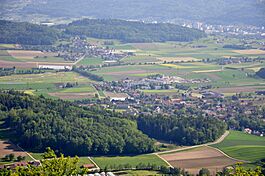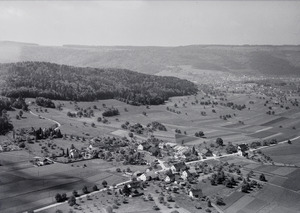Hüttikon facts for kids
Quick facts for kids
Hüttikon
|
||
|---|---|---|
 |
||
|
||
| Country | Switzerland | |
| Canton | Zurich | |
| District | Dielsdorf | |
| Area | ||
| • Total | 1.59 km2 (0.61 sq mi) | |
| Elevation | 433 m (1,421 ft) | |
| Population
(Dec 2020 )
|
||
| • Total | 951 | |
| • Density | 598.1/km2 (1,549/sq mi) | |
| Postal code |
8115
|
|
| Surrounded by | Dänikon, Oetwil an der Limmat, Otelfingen, Würenlos (AG) | |
Hüttikon is a small town, also called a municipality, located in the Dielsdorf district. It's part of the Zürich canton in Switzerland.
Contents
A Look Back: Hüttikon's History
Hüttikon has a long history! It was first written about in the year 883. Back then, it was known by a slightly different name: Huttinchova.
Geography of Hüttikon
Hüttikon covers an area of about 1.6 square kilometers. A large part of this land, about 52%, is used for farming. Forests cover about 36% of the area. The remaining 11.8% of the land is where buildings and roads are located.
This town is found in an area called the Furttal. It sits right on the border with the Canton of Aargau. Hüttikon includes the main village and a smaller settlement called Hüttikerberg.
People and Life in Hüttikon
Hüttikon has a population of 951 people (as of 31 December 2020). About 18.8% of the people living here are from other countries. Over the last ten years, the number of people living in Hüttikon has grown by about 24.4%.
Most people in Hüttikon speak German, which is about 89.3% of the population. Portuguese is the second most common language, spoken by 4.5% of residents. Italian is the third most common, spoken by 0.8% of the people.
Politics and Voting
In the 2007 election, the most popular political group was the SVP. They received 63.4% of the votes. Other popular parties included the SPS (10.6%), the FDP (8.3%), and the CSP (7.1%).
Age Groups and Education
Looking at the age of people in Hüttikon (as of 2000):
- Children and teenagers (0–19 years old) make up 23.3% of the population.
- Adults (20–64 years old) make up 66.4%.
- Seniors (over 64 years old) make up 10.3%.
Most people in Switzerland are well-educated. In Hüttikon, about 76.6% of adults aged 25 to 64 have finished high school or gone on to higher education, like a university.
Jobs and Economy
Hüttikon has a low unemployment rate of 1.42%. This means most people who want to work can find jobs.
As of 2005, jobs in Hüttikon were divided into three main types:
- Farming and Nature: 33 people worked in farming and related businesses. There were 11 businesses in this area.
- Making Things: 270 people worked in factories or making goods. There were 10 businesses in this area.
- Services: 45 people worked in service jobs, like shops or offices. There were 14 businesses in this area.
Population Changes Over Time
The table below shows how Hüttikon's population has changed throughout history:
| year | population |
|---|---|
| 1634 | 71 |
| 1836 | 167 |
| 1850 | 178 |
| 1900 | 120 |
| 1950 | 154 |
| 1970 | 256 |
| 2000 | 533 |
See also
 In Spanish: Hüttikon para niños
In Spanish: Hüttikon para niños





